
September 26, 2016 — For men with intermediate-risk prostate cancer, side effects at two years following radiation therapy (RT) were comparable for extremely-hypofractionated treatment and conventional treatment, according to research presented at the 58th Annual Meeting of the American Society for Radiation Oncology (ASTRO).
The extremely-hypofractionated treatment was delivered in seven fractions across two and a half weeks, while conventional treatment was delivered 39 fractions across eight weeks.
The HYPO-RT-PC trial — a randomized, multi-institutional phase III trial in Scandinavia — was designed to assess outcomes from highly accelerated extreme hypofractionation, which is delivered in smaller number of high doses — seven fractions of 6.1 Gy each in this study.
“Randomized trials have confirmed the value of radiation dose escalation for prostate tumors, and the potential benefits of larger radiation doses in fewer fractions are expected to increase the therapeutic efficacy for men with prostate cancer,” said Anders Widmark, M.D., a professor of radiation sciences at Umeå University in Umeå, Sweden and lead author of the study. “Most of the existing data on hypofractionation, however, draws on cases of moderately accelerated radiation treatment of the prostate, in contrast to our study with more extreme hypofractionation. Our trial shows that patients experience similar side effects at two years with highly accelerated extremely hypofractionation.”
Twelve hundred men with intermediate-risk prostate cancer were enrolled in the HYPO-RT-PC non-inferiority trial between 2005 and 2015. Eligible patients presented with tumor stages of T1c to T3a, prostate-specific androgen (PSA) levels of 20 or below, and one or two of three risk factors: stage T3a, a Gleason tumor score of seven or higher, or a PSA level greater than 10.
Patients were randomized to one of two treatment arms: The conventional fractionation group (CF) received 78 Gy of image-guided RT to the prostate in 39 treatments of 2 Gy each over eight weeks, and the extreme hypofractionation group (E-HF) received 42.7 Gy in seven treatments of 6.1 Gy each over two and a half weeks. Most patients (80 percent) received three-dimensional conformal RT (3DCRT), and the remaining patients received volumetric arc therapy (VMAT). Androgen deprivation therapy was not allowed among study participants.
Primary outcomes included physician-reported side effects measured via a modified RTOG scale and patient-reported outcomes of urinary, bowel and sexual function side effects measured with the Prostate Cancer Symptom Scale (PCSS) questionnaire. Side effects were measured prior to RT start (baseline), at the end of RT, and at three, six, 12, 18 and 24 months following completion of RT. Median follow-up time from randomization for the entire patient population was 4.2 years, and findings reflect the 866 patients who reached two-year follow-up at the time of reporting in May 2016.
Men who received extremely hypofractionated RT in seven treatments experienced similar side effects two years following treatment as those who received conventional RT in 39 treatments. Rates of physician-reported grade 2+ toxicities at two years following treatment did not differ significantly between treatment arms. Urinary side effects were reported for 5.4 percent of E-HF patients and 4.6 of CF patients (p = 0.59). Bowel side effects were reported for 2.2 percent of E-HF patients and 3.7 percent of CF patients (p = 0.20). Impotence at two years post-treatment was reported in 34 percent of both groups, compared to 16 percent among all participants at baseline. Patient-reported outcomes at two years following treatment also did not differ significantly between treatment groups for overall bother from urinary (p = 0.17), bowel (p = 0.12) or sexual function (p = 0.71) symptoms.
Some modest but statistically significant differences emerged between the accelerated and conventional treatment arms in shorter-term bowel and urinary side effects. Acute urinary toxicity immediately following treatment was similar for both treatment groups (27.6 percent for E-HF vs. 22.8 percent for C-HF, p = 0.11), although acute bowel toxicity at the end of RT was higher for the accelerated E-HF treatment than for CF (9.4 vs. 5.3 percent; p = 0.023). Patient-reported bowel function at the end of RT was also significantly worse following E-HF than following CF for seven of 10 symptoms assessed, although these differences dissipated at three and six months follow-up. At one year post-treatment, patient-reported urinary function was significantly worse among E-HF patients for four of the 14 symptoms measured.
“The trial was designed to have equal late toxicity, so although there were some differences in shorter-term side effects, the results for long-term toxicity were precisely what we hoped to find,” said Widmark. “Our plan moving forward is to analyze primary endpoint data and present updated toxicity results approximately one year from now.”
For more information: www.astro.org


 April 17, 2024
April 17, 2024 








